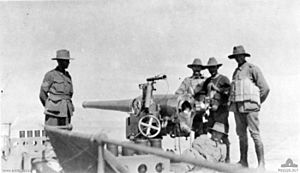QF 4-inch naval gun Mk I – III facts for kids
Quick facts for kids Ordnance QF 4-inch gun Mk I, II, III |
|
|---|---|

Australian troops with gun on a transport ship, circa. November 1914
|
|
| Type | Naval gun Coast defence gun |
| Place of origin | United Kingdom |
| Service history | |
| In service | 1896 - 1920 |
| Used by | British Empire |
| Wars | Boxer Rebellion, World War I |
| Production history | |
| Designed | 1895 |
| Specifications | |
| Mass | 2,912 pounds (1,321 kg) barrel & breech |
| Barrel length | 160 inches (4.064 m) bore (40 cal); 165.35 inches (4.200 m) total |
|
|
|
| Shell | Separate-loading QF 25 pounds (11.34 kg) Common pointed or Lyddite |
| Calibre | 4-inch (101.6 mm) |
| Breech | Single-motion screw |
| Muzzle velocity | 2,300 feet per second (700 m/s) |
| Maximum firing range | 9,000 yards (8,200 m) |
The QF 4-inch gun Mks I, II, III were early British "quick-firing" (QF) naval guns. They were first made in 1895. These guns had barrels that were 40 calibres long. A calibre is a way to measure the length of a gun's barrel compared to the size of its opening.
Contents
This gun was designed to be a stronger weapon than the older 3-inch QF 12-pounder gun. It was also meant to fire faster than the BL 4-inch gun.
The QF 4-inch gun was put on several types of British warships:
- Pelorus-class third-class protected cruisers (from 1896)
- Condor-class sloops (from 1898)
- Cadmus-class sloops (from 1900)
- Topaze-class third-class cruisers (launched in 1903)
- Invincible-class battlecruisers (from 1906)
The shells fired by this gun weighed about 25-pound (11 kg). However, these shells were not powerful enough to be a big improvement over the older 12-pounder gun. Because of this, newer and stronger guns, like the BL 4 inch gun Mk VIII, started to replace it on warships from 1907 onwards. The newer gun fired a heavier 31-pound (14 kg) shell.
Coast Defence: Protecting the Shore
Starting in 1906, many Mk III guns were moved from Royal Navy ships. They were then used as coast defence guns around the United Kingdom. These guns stayed in service until 1939, helping to protect the coastline.
By 1918, some of these guns were used at important locations. For example, three guns were at Dover Garrison and eight were at Forth Garrison. These garrisons were military bases set up to defend specific areas.
World War I: Guns on Land
During World War I, some of these naval guns were used on land. On September 20, 1914, the British cruiser HMS Pegasus was sunk in Zanzibar harbour. Her eight QF 4-inch Mk III guns were taken from the ship.
These recovered guns were then used on land during the East African campaign. Some were set up as coast defence guns in Zanzibar and Mombasa. Two of these guns, and later three, were used by the 10th Heavy Battery, a group of Royal Marines. They put the guns on special carriages that could be pulled by Packard lorries (trucks). REO lorries carried the ammunition for these guns.
Surviving Guns: Where Are They Now?
Some of these historic guns can still be seen today:
- One gun from HMS Pegasus, which was used in the World War I land campaign, is now outside Fort Jesus on Mombasa Island, Kenya. It is displayed next to a 10.5-cm gun from the German ship SMS Königsberg.
- A gun from HMAS Protector is on display outside the Elizabeth and Salisbury Navy Club in Elizabeth, South Australia.
- Another gun was put on the island of Hirta in the St Kilda archipelago, northwest Scotland, in 1918. This happened after a German submarine, SM U-90, attacked the island.
See also
- List of naval guns


